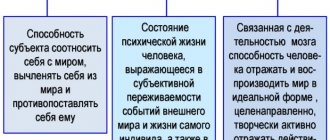Conscious mental processes
Definition 1
Conscious mental processes are those processes that are reflected in consciousness.
Consciousness is a person’s experience of events that occur in the external world. Consciousness is a function of the human brain. Thanks to consciousness, a person can receive ideas not only about the world around him, but also about himself. This function was formed in people as a result of evolution, but scientists have not fully figured out how this function was formed.
Conscious psychological processes are divided into three main groups:
- cognitive processes
- emotional processes
- volitional processes
Cognitive ones include:
sensations (this is a mental reflection of the characteristics of the surrounding world) representation (this is the reproduction of an image of some object or phenomenon from past experience) perception (a person’s subjective perception of the surrounding reality) memory (the accumulation, preservation and subsequent reproduction of knowledge) imagination (a person’s ability to build images in his mind, which were not perceived before) thinking (modeling of laws surrounding reality, the highest level of human cognition) attention (direction of perception towards some object or phenomenon, interests, needs, attitudes are responsible for attention, attention helps a person navigate the world around him) speech (form communication between people is built on the basis of language, on the one hand it is the process of reproducing thoughts, on the other hand it is the process of perceiving the thoughts of another person) reflection (a process during which a person concentrates on himself and his creation, on his interests, motives, values. In other words In other words, reflection is understood as a process when a person knows his knowledge and is aware of it.). The group of conscious psychological processes also includes emotional psychological processes:
The group of conscious psychological processes also includes emotional psychological processes:
- emotions (have an average duration, reflect a person’s assessment of situations in the objective world, have three main characteristics: reflected in the psyche, reflected in the systems of the whole organism, reflected in facial expressions, movements)
- feelings (reflect a person’s assessment of real and abstract objects)
- affects (an intense emotional process, short-term in duration, reflected in a person’s actions, as well as on the entire body as a whole)
- stress (the body’s reaction to unfavorable factors, can be neuropsychic and physical in nature.
Conscious psychological processes include volitional processes, such as:
- struggle of motives (this process is associated with the process of choice and determination)
- decision making (includes mathematical, statistical aspects, the study of the patterns of human choice)
- goal setting (a person’s understanding of his activities in terms of subsequent results)
Freud's unconscious
The Austrian psychologist and founder of psychoanalysis, Sigmund Freud, explaining the nature of the unconscious, cited the example of an iceberg. Thus, the conscious is only the tip, and its entire main part is unconscious processes.
Freud also believed that mistakes made by humans are not accidental. They arise when an unconscious intention “conflicts” with a conscious action. Errors are formed as a result of the predominance of unconscious desires over conscious ones.
As for the essence of dreams and daydreams, according to Freud’s theory, they also speak about a person’s unconscious desires and aspirations, about his unmet needs. In psychoanalysis, there are special methods designed to decipher dreams.
Freud developed a structure of the mind consisting of 3 levels:
- The conscious is the ego.
- Preconsciousness includes all human knowledge. If the information received is not needed by a person at the moment, then it is quickly forgotten. However, he can “extract” it if necessary. For example, if you ask a person what he ate for breakfast yesterday, a “folder” with this information will open in his head, and he will answer the question. He did not remember this throughout the entire time that had passed, but the information remained in his head.
- The unconscious stores all the most secret, terrible or, conversely, cherished thoughts and desires of a person, as well as unpleasant memories.
Intentionality
Intentionality is one of the properties of the model of mind. Depending on the abilities of the body, four orders are distinguished:
- First-order intentionality is characterized by understanding one's state of mind, one's beliefs and desires.
- The second order is the formation of ideas about other people’s states of mind.
- The third is shaping the thoughts and ideas of another person.
- The fourth is a whole chain of inferences about the ideas of others about previous or several different people.
If animals are characterized by intentionality of only the first two orders, then people usually operate with intentionality of the third and fourth order. It goes something like this: “My friend Sanford seems to realize that my daughter Olivia thinks his son Johnny thinks she’s cute.” They say that people can come up with the sixth order, but writing such a conclusion will require extremely great effort from the mind.
Mindfulness and Long-Term Thinking
The main criterion for awareness is long-term thinking. The more awareness, the more clearly a person predicts the future.
In an unconscious state, a person does not see the consequences of his actions.
The most vile traitors always hide among unconscious people. Unawareness disables the manifestation of higher human feelings: empathy, love, altruism. The intellect suffers.
Instead, we get callousness, fear, self-centeredness and stupidity.
A person performs actions that he desires in the future. Their consequences are sometimes irreparable.
It always takes a long time for an unconscious person to “catch up.”
What is visible from the position of awareness, regardless of the health of the unconscious, becomes obvious in the unconscious itself only when its state changes.
Only consciousness can make a long-term forecast.
A simple name is the key to success
The fluency effect discussed earlier is relevant not only for recipes and exercises, but also in larger situations. So, for example, when choosing a company to deposit savings, ease of pronunciation of the name is not the least important factor. The fact that investors tend to invest with great enthusiasm in companies with a simple name is confirmed by the statistics of companies on the New York Stock Exchange, given for the years 1990-2004. Similar results were obtained for IPOs on the American Stock Exchange. Although it is worth noting that this effect smooths out over time - as the company improves its reputation in the market.
Me and my desires
Unawareness is slavery to your momentary desires.
Leading an unconscious life always leads to associating oneself with one's lower needs.
Awareness is the setting of one’s “I” over desires, which, most often, do not reflect our true essence.
This is an opportunity to put yourself above the system that is your body.
In a state of unconsciousness there is no “I”. What a person associates with his own personality is constantly changing.
A conscious person leads the body towards the realization of aspirations determined by the mind. Unconscious - driven by orders from different senses.
The true “I want” is determined only in consciousness!
But not in the unconscious.
The popular call “Do what you want” is perceived differently by the mind and the unconscious.
For example, a conscious person puts his “I” above immediate feelings. He understands that he wants to make his contribution to this world, develop, find love, create conditions for maintaining and improving his health, acquire a favorite activity, become a professional in it and earn a certain amount of money for a happy life. Needs may differ, but they are always global in the scale of human life.
The unconscious person comes to the conclusion that she needs to buy beer, eat ice cream, troll online, or get any other momentary thrill in accordance with the level of development of the unconscious.
Hedonism does not lead to happiness precisely because it is not conscious. It does not satisfy the true needs of the individual. In an unconscious state, you cannot even see them.
"Conclusions"
Finally, I would like to briefly summarize all of the above. So:
- Consciousness is a programmer . The subconscious is a computer. The programmer has access to all computer resources;
- Consciousness interacts very closely with the subconscious. While awake, they communicate very actively with each other;
- The subconscious performs a mountain of routine work disguised from consciousness. The subconscious mind unloads the resource of the mind, performing many actions automatically;
- It is difficult for consciousness to resist emotional influxes. Often it cannot ignore them;
- Consciousness constantly corrects the programs of the subconscious, but does not know about it;
- Undesirable behavior , the purpose of which is unknown, is embedded in the reactive mind. There are effective approaches to working with behavioral programs embedded in the subconscious;
Author: Ivan Pirog
When publishing an article online, provide a link to the original. Thank you! =8-)
Every day I get better and better in every way
For 30 days, every evening before going to bed and in the morning after waking up, sitting comfortably in bed and completely relaxed, closing your eyes, as you exhale, say the phrase 30 times: “Every day I am getting better and better in every way.”
When pronouncing a phrase, do not focus your attention on it. Mentally bending your fingers will help you count. It is not recommended to pronounce the phrase in an active waking state. Example: while driving, at work, at lunch. We accompany the repetition of the phrase with visual pictures of the fulfillment of what we want, that is, we turn on the imagination as much as possible, dream as much and as often as possible! WE ONLY THINK ABOUT THE GOOD! WE TRY TO THINK ABOUT GOOD AND IN AN ACTIVE, AWAKE STATE!
WE ONLY THINK ABOUT THE GOOD! WE TRY TO THINK ABOUT GOOD AND IN AN ACTIVE, AWAKE STATE!
I scrupulously followed the instructions and a miracle really happened, but not after 30, but after 40 days. I came to the realization of a rather serious problem that was located in the unconscious zone. After realizing this problem, I understood how this technique works and I want to share my thoughts with you.
The unconscious, from all the variety of constructs presented in it, selects the most significant problem.
The unconscious adjusts the cognitive sphere (perception, attention, memory, etc.) to extract the necessary information from the reality around us. The fact is that in this world everything we need is present (i.e.
resources, information, knowledge, etc.), but due to the selectivity of our attention, we often lose sight of very important details. Or even, this information is already in us, but hidden in the unconscious, i.e. is in some kind of abrupt, “collapsed” form.
The unconscious begins to scrupulously collect this information and put it into clusters and structure it. In this case, it should be noted that this process occurs automatically, i.e. without spending any effort.
Ultimately, when all the necessary information has been collected, insight occurs, the puzzle comes together, and the information is presented in our minds in the form of a structured image.
However, it should be noted that at the initial stages of awareness, the mood and general condition may worsen, this is due to the fact that the unconscious does not really want to part with its concept of the world, for it it may be somewhat painful, but then new information is built into the unconscious and acceptance is coming. published by econet.ru
Author Nadezhdin Sergey
Illustrations by Sofia Bonati
Thematic selections of videos https://course.econet.ru/live-basket-privat in our closed club https://course.econet.ru/private-account
We have invested all our experience in this project and are now ready to share our secrets.
- SET 1. PSYCHOSOMATICS: REASONS THAT TRIGGER DISEASES
- SET 2. HEALTH MATRIX
- SET 3. HOW TO LOSE WEIGHT ONCE AND FOR ALL
- SET 4. CHILDREN
- SET 5. EFFECTIVE REJUVENATION METHODS
- SET 6. MONEY, DEBT AND CREDITS
- SET 7. PSYCHOLOGY OF RELATIONSHIPS. MAN AND WOMAN
- SET 8.RESULT
- SET 9. SELF-ESTEEM AND SELF-LOVE
- SET 10. STRESS, ANXIETY AND FEAR
PS And remember, just by changing your consciousness, we are changing the world together! econet
Unconscious motivators of conscious actions
The speed and accuracy of a person’s response to any stimulus depends on the skill of performing certain actions, so skill and attitude are in many ways the same thing. However, the skill manifests itself during the implementation of the action, while the attitude refers to the period preceding the implementation of the action.
Installation types:
— motor installation (readiness to perform a specific action),
— mental attitude (readiness to solve intellectual problems using known and accessible methods),
- perceptual attitude (readiness to perceive one thing and ignore another).
An attitude is also automatism, only automatism in the motivational sphere of a person; it is a preliminary adjustment of the body to perform certain actions. As a result of a whole series of experiments, D. N. Uznadze and his colleagues came to the conclusion that the installation is truly unconscious.
Interesting experiments were conducted with the formation of attitudes in subjects during hypnotic sleep: they were told, for example, that after some time they should go to a hanger and put someone else’s hat on their head. When the subjects actually did this, they were asked about the motives for this “strange” act. The subjects responded by coming up with all sorts of excuses.
The brain smoothes out a picture of the world whose interpretation is not universally accurate
The unconscious often prompts and gives the right advice, which can be life-saving. This is what is called instincts, human intuition. This should not be ignored. Philosophers have been arguing for centuries about the reality of the world that everyone perceives. Modern neuroscience believes that it is necessary to treat what is perceived as an illusion, since conscious information comes from the senses in an already processed form. The unconscious not only interprets the data received, but also improves them, smoothes out flaws and shortcomings, creating complete images based on incomplete data. This applies to hearing, vision, and other senses. For example, if you remove a syllable from a spoken sentence, the brain will independently come up with a gap in what it heard, depending on the meaning.
Unconscious mental processes
There are many mental processes that are not consciously recognized by the individual. These processes belong to the group of unconscious processes.
Note 1
Unconscious psychological processes differ from conscious ones in that a person is not able to independently control them.
The topic of unconsciousness is studied not only by psychologists, but by representatives of other disciplines, for example, philosophy, law, and psychiatry. But at the moment, despite the large number of studies carried out in various fields, only a small amount of information is available to scientists.
Unconscious mental processes are divided into three groups:
- unconscious mechanisms of conscious actions
- unconscious motivators of conscious actions
- "supraconscious" processes
Unconscious mechanisms of conscious actions include three subclasses:
- unconscious automatisms
- unconscious attitude phenomena
- unconscious accompaniments of conscious actions
Unconscious automatisms mean actions that are performed as if “by themselves.” For example, mechanical work that does not require stress on the brain. When our brain does not experience stress when performing work, this means that during this action the control of consciousness over this action is lost.
This group is also divided into:
- primary automatisms
- automated actions or skills
Primary automatisms are actions that are formed in a person at birth or were formed in the first year of life.
The second group includes processes that were initially conscious, but as a result of repeated repetition, became mechanical and unconscious.
Note 2
But it should be noted that when we perform unconscious automatisms, we still understand what we are doing, this indicates that consciousness is not homogeneous.
The phenomenon of unconscious attitude is a very important concept in psychology. An attitude is a person’s readiness to take an action.
Psychologists believe that skill and attitude are one and the same. But a skill appears while a person performs actions, then the attitude precedes the action. There are different settings:
- motor installation
- mental attitude
- perceptual attitude
Unconscious attitudes are important for conscious actions. Unconscious accompaniments of conscious actions are the third subclass of unconscious mechanisms
There are a large number of unconscious processes that simply accompany the action.
Unconscious accompaniments of conscious actions are the third subclass of unconscious mechanisms. There are a large number of unconscious processes that simply accompany the action.
We include involuntary movements, tonic tension, facial expressions and pantomime, as well as a large class of vegetative movements as involuntary accompaniments of conscious actions.
Another larger class of unconscious processes is the unconscious stimuli of conscious actions. Those actions that a person carries out unconsciously have a meaningful nature. Human behavior is governed by drives and desires. These drives and desires may be hidden deep in the subconscious, but can still control a person's behavior.
The third group includes “supraconscious” processes. Scientists include in this class what is formed as a result of strong conscious work, for example, when a person is engaged in solving a complex task assigned to him. A person first analyzes, selects possible options for solving this problem, and then the person comes to a solution to the problem assigned to him. The very process of the emergence of a solution remains unconscious to us. In other words, it is called intuition.
Characteristics of the theory
Now the study of the area of the unconscious occurs according to one of the theories that were developed by outstanding psychologists. The main theories belong to Lacan, Jung, Freud.
According to Freud
Sigmund Freud had his own idea about the unconscious. He attributed to this area actions in which a person is not aware. He argued that the psyche itself pushes into the realm of the unconscious secrets, fantasies, desires that contradict the moral principles of society and disturb a person too much.
According to Jung
Carl Jung contributed to the expansion of the concept. He created a separate discipline - analytical psychology, for which he developed the term “collective unconscious”. The scientist introduced significant changes if we compare his theory with psychoanalysis.
Jung divided the unconscious into two layers:
- Personal - he referred to it as individual mental processes.
- Collective - processes affecting a group of people.
The group unconscious is a collection of static forms (dominants or archetypes). Initially they are innate, but over time they can be updated.
According to Lacan
The next assumption regarding the unconscious was made by the French psychoanalyst Jacques Lacan. He suggested that the area of the unconscious is constructed as speech, but one cannot accept Lacan's assumption that the unconscious is a language, since this is a kind of metaphor. Its decoding - the unconscious is similar to language, as it works on similar rules. However, it cannot be exhausted by the laws of linguistics.
Unconscious contents of the psyche
The category of the unconscious includes a variety of mental processes that have different names within the framework of different theoretical concepts. First of all, these are mental processes associated with automated behavior controlled under the cortical structures of the brain. This includes numerous signals coming from internal organs, joints, muscle spindles, skin surface, receptors throughout the body, the insignificant strength of irritation of which does not allow them to become a priority and be recognized. P.V. Simonov gives p uc . ll . l .
m. Frank.
Dwelling (Science. 1998. this group of mental phenomena May/June). the name is preconscious.
251
Patients who lose consciousness during surgery often report later that at that moment they heard doctors talking about their condition, felt the pressure of the needle with which drugs were injected, but could not move or communicate with others. Their memory was capable of retaining information about these events.
The unconscious also includes those phenomena that were once conscious and can be conscious again under certain conditions, but are currently not included in the sphere of consciousness. Indeed, every person at different moments in life is aware of a wide variety of information. Having ceased to be a priority, it does not disappear forever, but persists and waits in the wings. Moreover, it can participate in regulating human behavior without entering the realm of awareness. These unconscious contents are called preconscious
within the framework of the psychoanalytic concept and
the subconscious
according to the classification of P.V. Simonova.
And finally, the unconscious refers to the unconscious -
central concept of psychoanalytic theory. By definition, the unconscious is that part of the psyche whose contents cannot become conscious without the use of special (psychoanalytic) techniques. It includes instinctual desires, emotions and repressed thoughts (Figure 11.2).
The structure of the unconscious is absent in the concept of P.V. Simonov, but there is another structure in it - superconsciousness, or intuition. It, unlike the subconscious, devoid of creativity, is a source of new hypotheses and discoveries.
The division of the psyche into consciousness and unconscious processes raises the question of how information is translated into the category of conscious or unconscious. If for automated behavior and preconsciousness the reason for being outside consciousness may be the lack of priority or weakness of impulses (Libet, 1991) (this mechanism will be discussed in Chapter 12), then in the case of the unconscious, from the point of view of psychoanalysis, consciousness has special reasons not to allow its contents to become conscious.
“What just happened?”
Consciousness does not have direct access to long-term memory . The storage and reproduction of such memories is carried out by the residents of the city of Hippocampus in the state of the Limbic System on the planet Human Brain.
The glorious city of Hippocampus is located on the territory of the continent of Subconscious. Consciousness usually communicates with it via telegraph.
So, consciousness decided on the wording of the telegram and sent it to the address: Subconscious Continent, Limbic System, city of Hippocampus, PO Box 91, index: 37072, to the girl Vika at the reception.
Request accepted . The hippocampus turns to the Archive of Memories. There, a selection of memories that satisfy the request occurs. And, after a few moments, consciousness receives a message in which it discovers:
- Several short videos with quality similar to a mobile phone camera;
- A package with a set of additional visual images and associations, as well as a booklet with the text of thoughts;
If the consciousness decides to relive emotions, smells or tastes, it sends another telegram to the Hippocampus with a request to immediately restore bodily sensations corresponding to the recalled situation.
Ugh, you! It turns out to be some kind of bureaucracy... Well, oh well.
The archive retrieves memories of emotions and sensations. Then he sends the information further - into the depths of the subconscious - to the village of the Almond Body!
The village of Almond Body is surrounded on all sides by almond fields. Village residents annually set records for harvesting potatoes and carrots. Additionally, they are involved in the formation of emotions and feelings. Both negative and positive.
The chemical laboratory of the Amygdala selects the desired composition of hormones and releases them into the blood. This changes your heart rate and breathing depth. Bodily sensations and emotions arise. Some muscles are tense.
Of course, all this is very simplified, but it explains the essence of the issue well.
What was I leading to? Moreover, sometimes we cannot even imagine how closely we interact with our subconscious . This is a constant exchange of colossal amounts of information, occurring without much effort.
But these are just flowers... Let's get down to business.
Mindfulness and Love
A person confuses love with a lot of other states. Sympathy, love, emotional dependence, habit, sense of ownership. All this in popular culture is called love.
But love does not exist in an unconscious state. Feelings pass quickly, as they are an element of the unconscious perception of another person.
Love is a conscious renunciation of selfishness in favor of another person.
And this is a completely different level of feeling.
The less aware a person is of himself, the less true love he has.
Therefore, if you strive to find love, first try to gain awareness.
Lack of awareness is fixable
For everyone who recognizes themselves in the description of an unconscious person, there is good news: it can be fixed!
We all go through a phase of unawareness during childhood. The child does not think in terms of long-term goals; he is not able to understand the true reasons and meanings of his actions.
While consciousness has not yet developed in the little man, his survival is ensured by his parents.
An adult cannot afford to remain unconscious. However, each of us is, to one degree or another, susceptible to unconscious states. You just need to work through them without reproaching yourself for wrong actions or thoughts.
Developing mindfulness is hard work. But it always pays off by achieving higher tastes in life.
The role of the unconscious in human life
The unconscious is guided by principles of pleasure that have no relation to reality and time.
The unconscious manifests itself in a person's daily life in many things. For example, this could be a slip of the tongue when communicating with people. It often contains a person’s true thoughts and motives, which he diligently hides. It slips when unconscious aspirations collide with conscious goals of behavior, which ultimately creates contradictions with disguised true motives.
The fact that a person forgets the names of others is also an example of the unconscious. We don't remember a person's name unless we consider it the most important and significant. It takes us a long time to retrieve information about his name from memory, and this process of remembering occurs against our will.
Each of us performs certain unplanned movements, brought to the point of automaticity. At first they are performed consciously, then they are consolidated in the subconscious and become part of the unconscious. These include:
- reading;
- writing ability;
- acquisition of speech skills;
- ability to walk.
Having brought these actions to automaticity, after time has passed we do not have to turn on consciousness when performing them.
Dreams are another form of the unconscious. They express our true thoughts, fears, cherished desires, and feelings. They are not always specified and can be expressed through symbols.
“What is unconscious behavior?”
Any uncontrollable outbursts of anger for which we blame ourselves. Laziness, addiction to alcohol, smoking or excessive eating. Uncontrollable fears and doubts, quarrels with loved ones.
All this is unconscious behavior. A person does wrong, understands it, but cannot change anything. A reasonable approach to solving a problem does not change his behavior for the better.
This article is a continuation of the “Formula for Any Problem”. If you haven't read it, I recommend checking it out.
Well, are you ready to descend into the dark basements of the subconscious? Then what are we waiting for!
Unconscious automatisms
The processes included in the subclass of unconscious automatisms are of a dual nature:
- never realized before (fundamentally not realized),
- once conscious, but at the moment occurring automatically (skills).
Examples of fundamentally unconscious ones: a child’s sucking movements, blinking, eye convergence, grasping objects, walking and much more. Examples of skills: playing a musical instrument, writing, speaking a foreign language, and an endless number of other skills.
It is worth noting that psychologists distinguish in the structure of consciousness:
- focus of consciousness (the most important thing at the current moment in time),
- periphery of consciousness (weak control by consciousness is exercised),
— the boundary of consciousness (the processes located here can either leave the field of human consciousness or enter it),
- unconscious.
Developed skills usually “balance” on the border of consciousness. If a person begins to make a lot of mistakes (when tired, for example, or when the activity becomes more complicated), then the skill again falls into the field of consciousness, to its periphery or even into focus. The skill is controlled, improved, and then returns again to the border of consciousness. This is what distinguishes skills from fundamentally unconscious processes, in that they “wander.”
Various examples of automatisms:
- when reading any text fluently, we do not think about the outline and meaning of individual letters, but “immediately” perceive the meaning of what we read,
- a radio operator working with Morse code, perceiving the sound of short and long signals, completely freely translates them into a logical combination of letters and words,
— entering a dark room, the hand “itself” reaches for the switch.
Dictionary of antonyms
CONSCIOUSNESS - UNCONSCIOUSNESS
Consciousness of actions - unconsciousness of actions.
CONSCIOUSNESS - UNCONSCIOUSNESS
Tatyana suddenly decides to write to Onegin: the act is naive and noble, but its source lies not in consciousness, but in unconsciousness: the poor girl did not know what she was doing.
Belinsky. Works of Alexander Pushkin. People always love through something: through a word or through silence, through explosive passion or through restrained and subtle lyrics, through subordination or subordination of oneself, through the flesh or through the spirit, through consciousness or through unconsciousness, through similarities or through differences, and so on. further, and so on. Zalygin. After the storm. CONSCIOUS - UNCONSCIOUS Conscious - unconscious consciousness - unconsciousness consciousness - unconsciousness conscious - unconscious consciously - unconsciously consciousness - unconsciousness conscious - unconscious consciously - unconsciously awareness - unconsciousness conscious - subconscious consciously - subconsciously
Conscious efforts - unconscious efforts.
Ο Observing any act of memory, we will certainly notice in it a conscious element: we are aware of what we remember, and an unconscious element: we are not aware of what is stored in our memory. Ushinsky. Educational anthropology. One such conscious fighter is worth more than a hundred, albeit daring, but unconscious brave men. Furmanov. Conscious heroes. ~ In meaning noun Wed R. We know very well to what extent mental mental life is variegatedly composed of the conscious and the unconscious. I. Pavlov. Pavlovsk environments. But we will simplify the situation if we do not notice that Suvorov’s conscious often changed places with the unconscious. Lotman. Conversations about Russian culture. CONSCIOUS - UNCONSCIOUS
Conscious actions - unconscious actions.
Ο Behind this kind of attitude towards his biography as a writer, Astafiev sees a conscious or unconscious desire of critics to ensure that “the reader is as lenient as possible towards me.” F. Kuznetsov. I am responsible for everything. CONSCIOUS - SPONTANEOUS Conscious - spontaneous consciousness - spontaneous
Conscious actions - spontaneous actions.
Ο A realist is always a dialecticist by nature, conscious or spontaneous. Pudovkin. Realism, naturalism and Stanislavsky’s “system”. After the war, a rise in spirit is very possible. But it is required that this rise be conscious, and not spontaneous. M. Gorky. Letter from S.V. Malyshev, May-June 1915. CONSCIOUS - MACHINAL Conscious - mechanical consciousness - mechanicalness
Out of mechanical habit, the dog tucked its tail between its legs when it ran away from you, but it ran out of a conscious thought. Chernyshevsky. Anthropological principle in philosophy.











